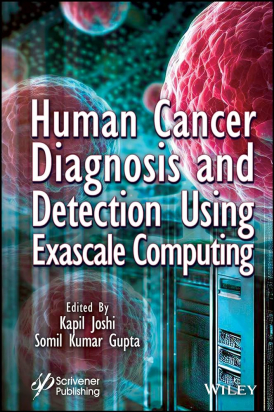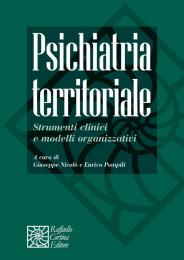Non ci sono recensioni
DA SCONTARE
Human Cancer Diagnosis and Detection Using Exascale Computing
The book provides an in-depth exploration of how high-performance computing, particularly exascale computing, can be used to revolutionize cancer diagnosis and detection; it also serves as a bridge between the worlds of computational science and clinical oncology.
Exascale computing has the potential to increase our ability in terms of computation to develop efficient methods for a better healthcare system. This technology promises to revolutionize cancer diagnosis and detection, ushering in an era of unprecedented precision, speed, and efficiency. The fusion of exascale computing with the field of oncology has the potential to redefine the boundaries of what is possible in the fight against cancer.
The book is a comprehensive exploration of this transformative unification of science, medicine, and technology. It delves deeply into the realm of exascale computing and its profound implications for cancer research and patient care. The 18 chapters are authored by experts from diverse fields who have dedicated their careers to pushing the boundaries of what is achievable in the realm of cancer diagnosis and detection. The chapters cover a wide range of topics, from the fundamentals of exascale computing and its application to cancer genomics to the development of advanced imaging techniques and machine learning algorithms. Explored is the integration of data analytics, artificial intelligence, and high-performance computing to move cancer research to the next phase and support the creation of novel medical tools and technology for the detection and diagnosis of cancer.
Audience
This book has a wide audience from both computer sciences (information technology, computer vision, artificial intelligence, software engineering, applied mathematics) and the medical field (biomedical engineering, bioinformatics, oncology). Researchers, practitioners and students will find this groundbreaking book novel and very useful.
Preface xiii
1 Evaluating the Impact of Healthcare 4.0 on the Performance of Hospitals 1
Pramod Kumar, Nitu Maurya, Keerthiraj, Somanchi Hari Krishna, Geetha Manoharan and Anupama Bharti
1.1 Introduction 2
1.2 Literature Review 4
1.3 Methodology 6
1.3.1 Selection of the Sample and Characterization 6
1.3.2 Creation of a Data-Gathering Tool and Measures 7
1.3.3 Inspection of the Conceptions’ Reliability and Validity 8
1.3.4 Data Evaluation 8
1.4 Result and Discussion 9
1.5 Conclusion 11
References 12
2 Human Breast Cancer Classification Employing the Machine Learning Ensemble 19
Sreenivas Mekala, S. Srinivasulu Raju, M. Gomathi, Naga Venkateshwara Rao K., Kothandaraman D. and Saurabh Sharma
2.1 Introduction 20
2.1.1 Breast Cancer Symptoms and Signs 20
2.1.2 Breast Cancer Risk Factors 21
2.1.3 Disease Prediction Using Machine Learning 22
2.2 Literature Review 22
2.3 Methodology 24
2.3.1 Bayesian Network 24
2.3.2 Radial Basis Function 25
2.3.3 Ensemble Learning 26
2.3.4 The Suggested Algorithm 27
2.4 Results and Discussion 28
2.5 Conclusion 31
References 31
3 Multi-Objective Differential Development Using DNN for Multimodality Medical Image Fusion 35
M. Ranjith Kumar, Abhishek Dondapati, Dilip Kumar Sharma, Prakash Pareek, Rajchandar K. and S. Shalini
3.1 Introduction 36
3.2 Literature Review 37
3.3 Methodology 38
3.3.1 Non-Subsampled Contourlet Transform 40
3.3.2 Deep Xception Mode Feature Extraction 40
3.3.3 Differential Evolutions with Several Objectives for Feature Selection 41
3.3.4 Fusion of High-Frequency Bands 41
3.4 Result and Discussion 41
3.4.1 Visual Evaluation 41
3.4.2 Quantitative Research 43
3.5 Conclusion 47
References 47
4 Multimodal Deep Learning Analysis for Biomedical Data Fusion 53
Divyanshu Sinha, B. Jogeswara Rao, D. Khalandar Basha, Parvathapuram Pavan Kumar, N. Shilpa and Saurabh Sharma
4.1 Introduction 54
4.2 Literature Review 56
4.3 Methodology 58
4.3.1 Early Fusion 59
4.3.2 Intermediate Fusion 60
4.3.3 Late Fusion 62
4.4 Results and Discussion 62
4.5 Conclusion 64
References 65
5 Developing Robot-Based Neurorehabilitation Exercises Using a Teaching–Training Process 71
W. Vinu, Sonali Vyas, A. Chandrashekhar, T. Ch. Anil Kumar, T. Raghu and Mohit Tiwari
5.1 Introduction 72
5.1.1 Research Gap 74
5.1.2 Research Aim 74
5.2 Literature Review 74
5.3 Research Methodology 77
5.4 Results 78
5.5 Conclusion 81
5.6 Future Research Directions 82
References 83
6 Investigation on Introduction to Heterogeneous Exascale Computing in the Medical Field 87
M. Pyingkodi, Raju Shanmugam, Dilip Kumar Sharma, Deepesh Lall, S. Deepan and B. Dasu
6.1 Introduction 88
6.1.1 Research Gap 89
6.2 Literature Review 89
6.3 Research Methodology 92
6.4 Results and Discussion 94
6.5 Conclusion 96
6.6 Future Research Direction 96
References 97
7 Adoption of Cloud Computing in the Healthcare Field Using the SEM Approach 101
R. Chithambaramani, C. Balakumar, Dilip Kumar Sharma, Keyur Patel, Bhavana Jamalpur and M. R. Arun
7.1 Introduction 102
7.1.1 Research Gap 103
7.1.2 Research Aim 103
7.2 Literature Review 104
7.3 Research Methodology 106
7.3.1 Research Hypothesis 107
7.3.2 Data Analysis 107
7.4 Results and Discussion 107
7.5 Implications 110
7.6 Conclusion 110
7.7 Future Research Directions 111
References 112
8 Chest X-Ray Analysis for COVID-19 Diagnosis Using an Exascale Computation and Machine Learning Framework 115
M. Dhinakaran, S. Deivasigamani, Saikat Kar, Nishakar Kankalla, V. Malathy and Saurabh Sharma
8.1 Introduction 116
8.2 Literature Review 117
8.3 Research Methodology 119
8.4 Analysis and Discussion 120
8.5 Conclusion 130
References 131
9 3D-Printed Human Organ Designs with Tissue Physical Characteristics and Embedded Sensors 135
A. Chandrashekhar, R. Raffik, R. Sridevi, M. Sindhu, Kodela Rajkumar and Tarun Jaiswal
9.1 Introduction 136
9.2 Literature Review 137
9.3 Methodology 139
9.4 Analysis and Discussion 140
9.5 Conclusion 149
References 150
10 Fast Computing Network Infrastructure for Healthcare Systems Based on 6G Future Perspective 153
Ranjeet Yadav, S. L. Prathapa Reddy, Akshay Upmanyu, Ravi Kumar Sanapala, V. Malathy and Umakant Bhaskar Gohatre
10.1 Introduction 154
10.2 Literature Review 155
10.3 Research Methodology 157
10.4 Analysis and Discussion 158
10.5 Conclusion 167
References 168
11 Analysis of Multimodality Fusion of Medical Image Segmentation Employing Deep Learning 171
G. Santhakumar, Dattatray G. Takale, Swati Tyagi, Raju Anitha, Mohit Tiwari and Joshuva Arockia Dhanraj
11.1 Introduction 172
11.1.1 Research Gap 174
11.1.2 Research Aim 174
11.2 Literature Review 174
11.3 Research Methodology 176
11.4 Results and Discussion 177
11.5 Conclusion 180
References 181
12 New Perspectives, Challenges, and Advances in Data Fusion in Neuroimaging 185
Pedada Sujata, Dattatray G. Takale, Swati Tyagi, Saniya Bhalerao, Mohit Tiwari and Joshuva Arockia Dhanraj
12.1 Introduction 186
12.1.1 Research Gap 188
12.2 Literature Review 188
12.3 Research Methodology 190
12.3.1 Human Brain Temporal and Spatial Data Mining Using FOCA and Data Fusion 190
12.3.2 Construction of the Multimodal Neuroimaging Data Fusion 190
12.4 Results and Discussion 191
12.4.1 EEG–fMRI Shared Multimodal Simulation Evaluation 192
12.4.2 Implementation of Multimodal Neuroimaging Data Fusion 192
12.5 Challenges 194
12.6 Conclusion 195
References 196
13 The Potential of Cloud Computing in Medical Big Data Processing Systems 199
A. Mallareddy, M. Jaiganesh, Sophia Navis Mary, Manikandan K., Umakant Bhaskar Gohatre and Joshuva Arockia Dhanraj
13.1 Introduction 200
13.2 Literature Review 202
13.3 Materials and Method 203
13.4 Result and Discussion 206
13.5 Conclusion 210
References 211
14 Deep Learning (DL) on Exascale Computing to Speed Up Cancer Investigation 215
D. Rubidha Devi, S. Ashwini, Samreen Rizvi, P. Venkata Hari Prasad, Mohit Tiwari and Joshuva Arockia Dhanraj
14.1 Introduction 216
14.2 Literature Review 217
14.3 Research Methodology 219
14.4 Analysis and Discussion 220
14.5 Conclusion 223
References 224
15 Current Breakthroughs and Future Perspectives in Surgery Based on AI-Based Computing Vision 227
Suneet Gupta, Madhu Kumar Vanteru, Sanjeevkumar Angadi, Manikandan K., Mohit Tiwari and Joshuva Arockia Dhanraj
15.1 Introduction 228
15.2 Literature Review 229
15.3 Research Methodology 231
15.4 Analysis and Discussion 232
15.5 Conclusion 235
References 236
16 MRI-Based Brain Tumor Detection Using Machine Learning 239
Vivek Kumar, Pinki Chugh, Bhuprabha Bharti, Anchit Bijalwan, Amrendra Tripathi, Ram Narayan and Kapil Joshi
16.1 Introduction 240
16.2 Pre-Processing 242
16.3 Segmentation 243
16.4 Feature Extraction 244
16.5 SVM Classifier 246
16.6 Methodology 248
16.7 Conclusion 249
References 249
17 Chili Pepper as a Natural Therapeutic Drug: A Review of Its Anticancer and Antioxidant Properties and Mechanism of Action Using the Machine Learning Approach 253
Rachana Joshi, Narinder Kumar, B. S. Rawat, Reena Dhyani, Hemlata Sharma and Rajiv Kumar
17.1 Introduction 254
17.2 Machine Learning Technique 255
17.3 Composition Profile 255
17.4 Reactions of Phytochemicals to Drying and Ripening 256
17.5 Antioxidant Activity 257
17.6 Anticancer Activity 258
17.7 Activities that are Anti-Inflammatory and Relieve Pain 260
17.8 Activities Controlling Diabetes and Hyperglycemia 260
17.9 The Impacts of Anticholesteremic Activity on Lipid Metabolism 262
17.10 Anticlotting Effect 262
17.11 Antimicrobial Activity 263
17.12 Immune Checkpoint Signaling 263
17.13 Suppression of Antitumor Immune Response 264
17.14 Antigen Masking 264
17.15 Immune-Based Cancer Therapies 264
17.16 Other Miscellaneous Medicinal Values 265
17.17 Conclusion 267
References 268
18 Exascale Computing: The Next Frontier of High-Performance Computing 279
Rashmi M., Girija D.K. and Yogeesh N.
18.1 Introduction 280
18.1.1 Literature Study 281
18.2 Exascale Computing 282
18.2.1 Exascale Computers 283
18.2.2 Case Study 284
18.2.3 Measuring Computer Speed 285
18.2.4 Usage of FLOPS in Supercomputers 286
18.2.5 Exascale Computing: A Crucial Technology 290
18.2.6 Requirements of High-Speed Computers 291
18.2.7 Milestones 292
18.2.8 Exascale Computing Processing 293
18.2.9 Advantages of Exascale Computing 294
18.2.10 Exascale Computing in Various Domains 295
18.2.11 Exascale Computer: A Supercomputer 297
18.2.12 Exascale Computing Different from Quantum Computing 298
18.3 Exascale Computing Challenges 299
18.4 Future Lookup 301
18.4.1 Needed Improvements 301
18.5 Conclusion 302
References 303
Index 305




